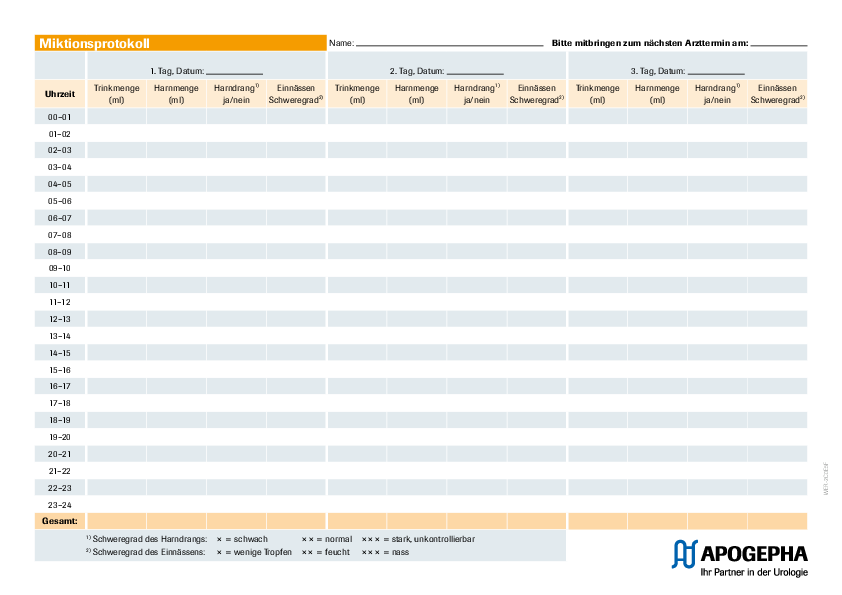Symptoms
Irritable bladder: clinical picture, symptoms and progression
Irritable bladder is a bladder irritation characterised by pain when urinating and a frequent and urgent need to urinate, often without the bladder being completely full. Spasmodic discomfort in the lower abdomen is also a typical symptom. The exact causes are often unclear, but can be triggered by various factors such as stress or certain foods.
Irritable bladder, overactive bladder and bladder weakness - what's the difference?
People with an overactive bladder often feel the need to empty their bladder more frequently and more urgently than usual, without it actually being full. This can lead to a sudden, strong urge to urinate, which is difficult to control. Numerous visits to the toilet, both during the day and at night, are typical of an overactive bladder.
On the other hand,bladder weakness also called urinary incontinence, is the inability to control urine flow, which can lead to involuntary urine discharge. There are various forms of incontinence, including stress incontinence (loss of urine when coughing, sneezing or during physical exertion) and urge incontinence (strong, sudden urge to urinate, followed by uncontrolled urine discharge).
Good to know:
Be it irritable bladder, overactive bladder or bladder weakness: incorrect habits and shyness to talk about the complaints are often the cause of a suffering that lasts longer than necessary. It is not uncommon for affected persons to suffer from unpleasant symptoms several times a year. If a person suffers from an irritable bladder more than six times a year, it is called chronic irritable bladder. 1
Women are more likely to have an irritable bladder
Different anatomical and hormonal conditions contribute to the fact that women are much more prone to an irritable bladder than men.1 The female urethra is considerably shorter than the male urethra. This makes it easier for germs to penetrate and increases the incidence of infections. If these are not detected by standard detection methods, the doctor does not initially suspect an infection.
Cycle-related hormonal fluctuations and/or changes in the interaction of hormones during and after menopause are another factor for an irritable bladder, for example, with a constant urge to urinate. Irritable bladder can affect women of any age. With increasing age, however, the probability of suffering from its symptoms also increases.1
Typical symptoms of irritable bladder
Irritable bladder often starts with a sudden, frequent urge to urinate and pain or burning when urinating, without necessarily being accompanied by an infection. Symptoms can last for a long time and lead to frequent trips to the toilet (even at night), which can significantly impair the quality of life.
The classic symptoms of an irritable bladder include:1,2
- Frequent urge to urinate even though the bladder is not full
- Only small amounts of urine when urinating
- Spasmodic pain in the abdomen
- Burning sensation with urination
- No feeling of relief after urination
- Pain, especially during daytime
- Troubles during the menstrual cycle and in sexual life
Important to know: Symptoms of an irritable bladder can be easily confused with the symptoms of an overactive bladder.
Causes
Irritable bladder has various causes
Often, medical examination does not reveal any concrete findings. The doctor can neither identify organic causes nor detect a urinary tract infection. In many cases, irritable bladder is not triggered by a single cause, but several simultaneous causes can trigger its symptoms.
The most frequent triggers are:2
- Hypothermia, drenching
- Psychological factors, in particular, anxiety, anger, stress
- Inflammations
- Hormonal fluctuations
- Hormone deficiency, in particular, oestrogen deficiency
- Changes in the urinary tract due to age
- Foreign bodies
- Side effect of diuretic medication and agents
In rare cases, serious diseases can also develop the symptoms of irritable bladder, for example neurological diseases or cancers. Irritable bladder can also result from abdominal surgery.
Very important:
if you experience fever and fatigue in addition to the usual symptoms or if you notice blood in your urine, you should consult a doctor immediately!
Diagnosis of an irritable bladder is ultimately a diagnosis by exclusion. The following can help with this:
- Anamnesis
- Physical examination
- Analysis of vaginal discharge and urine
- Determination of residual urine
- Uroflowmetry and/or urodynamics if necessary
Treatment
Treating an irritable bladder
About 7 million people (most of them women) suffer from an irritable bladder in Germany (plus a large number of unreported cases), and the condition is an everyday occurrence for doctors - whether they are general practitioners, internists, urologists or gynaecologists3. Therefore, you should talk openly about your symptoms with your doctor, even if it is difficult to do so. They can inform you about the treatment options:2
![[Translate to English:] Eine Reizblase behandeln](/fileadmin/_processed_/5/3/csm_AdobeStock_700260671_188a50fde3.jpg)
- Medication
- Change in lifestyle and eating habits
- Bladder training and pelvic floor exercises
- Electrical stimulation of bladder muscles
- Administration of oestrogen in case of a deficiency
- Surgical measures such as injecting the bladder wall
Prevention
Long-term prevention of irritable bladder
Some practices have proven effective in normalising the constant and painful urge to urinate in the long term:
- Drink a lot of fluids: slowly increase your daily fluid intake to at least two litres (water, herbal tea, juice spritzers but not coke, lemonade, coffee or black tea).
- Food: eat more diuretic foods, for example potatoes, rice and asparagus.
- Keep warm: protect yourself from hypothermia and wet conditions.
- Relax: deal with stressful situations consciously and try out some relaxation techniques to become calmer and more composed.
- Exercise: strengthen your pelvic floor by doing specific gymnastic exercises.
- Bladder training: exercise the sphincters of the bladder by consciously and continuously increasing urination intervals. Relax the sphincter while urinating. Do not tighten it and simply let the urine pass.
![[Translate to English:] Wassergläser: Ausreichend Flüssigkeit kann dabei helfen, einer Reizblase vorzubeugen.](/fileadmin/apogepha/mood-fotos-stock/csm_reizblase-wasserglaeser_4b710bf9fa.png)
Downloads
Service material for download
Download free service material on irritable bladder here with just one click:
FAQs
Frequently asked questions and answers about irritable bladder
Signs of an irritable bladder include a sudden, difficult to control urge to urinate with only a small amount of urine, and frequent urination. Involuntary urination may also occur if the urge to urinate becomes too strong. A burning sensation when urinating and spasmodic discomfort in the lower abdomen are also typical.
Yes, an irritable bladder can have psychological causes. Stress and anxiety can aggravate the symptoms of irritable bladder.
Irritable bladder is a (chronic) condition that results in a frequent and urgent need to urinate due to involuntary bladder contractions without the presence of an infection. In contrast, cystitis is usually caused by a bacterial infection that causes inflammation and a burning sensation when urinating.
A constant urge to urinate can be caused by urinary tract infections, diabetes, an irritable or overactive bladder, prostate problems or chronic cystitis, among other things. Certain medications, excessive consumption of caffeine or alcohol and pregnancy can also cause frequent urination.
The symptoms of irritable bladder can improve with the right treatment and lifestyle changes. Although the condition can be chronic and often long lasting, many patients can find relief through dietary changes, bladder training, medication and physiotherapy.
Consult your family doctor first. They will decide if they can help you or if you need to be referred to a specialist, such as a urologist or gynaecologist. If the measures taken by your family doctor do not work, insist on a referral to a urologist.
You can support the treatment of an irritable bladder with bladder training.4 This includes emptying the bladder regularly according to a fixed schedule and allowing longer periods between visits to the toilet. Certain exercises strengthen the pelvic floor muscles, which improves bladder control.
Teas are ideal for hydration, but are not suitable as the sole treatment for urinary tract problems. The active ingredients in teas are present in very low doses compared to medicines and have little effect. Medicines, on the other hand, are subject to strict controls and constant levels of active ingredients.
Many people have a low fluid intake, which reduces kidney activity and makes the blood more viscous. Low fluid intake also leads to concentrated urine, which further irritates the bladder. Keep water bottles handy and drink regularly to make it a habit.
Sources
- 1 „Chronische Reizblase – Klinikum Kulmbach“. Klinikum-kulmbach.de, https://www.klinikum-kulmbach.de/leistungsspektrum/spalte-1/klinikum-kulmbach/klinik-fuer-urologie/behandlungsschwerpunkte/chronische-reizblase.html. Zugegriffen 19. Juli 2024.
- 2 „Reizblase: Ursachen & Therapie“. KontinenzZentrum Hirslanden Zürich, https://www.kontinenzzentrum.ch/de/erkrankungen/blasenfunktionsstoerung/reizblase.html. Zugegriffen 19. Juli 2024.
- 3 „Tee für den Harn-Trakt“. PTA-Forum online, von https://ptaforum.pharmazeutische-zeitung.de/ausgabe-062011/tee-fuer-den-harn-trakt/. Zugegriffen 19. Juli 2024.
- 4 Burgio, K. L., Kraus, S. R., Johnson, T. M., II, Markland, A. D., Vaughan, C. P., Li, P., Redden, D. T., & Goode, P. S. (2020). Effectiveness of combined behavioral and drug therapy for overactive bladder symptoms in men: A randomized clinical trial. JAMA Internal Medicine, 180(3), 411. https://doi.org/10.1001/jamainternmed.2019.6398

![[Translate to English:] Frau mit Buch und Tee in der Küche: Viel trinken kann gegen eine Reizblase helfen.](/fileadmin/_processed_/0/a/csm_header-reizblase_13ac212f2b.png)
![[Translate to English:] Harnblase](/fileadmin/_processed_/b/f/csm_harnblase-apogepha-illustration_b6bd41fd13.png)



![[Translate to English:] [Translate to English:]](/fileadmin/apogepha/produktbilder/APO_UROL_20_3D_4_RGB_free_2108233.png)
![[Translate to English:] [Translate to English:]](/fileadmin/apogepha/image-header/header-OAB.png)